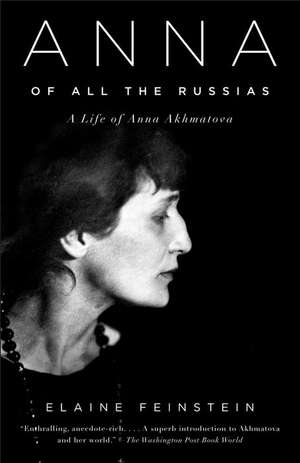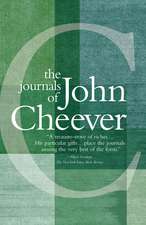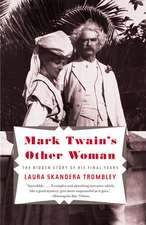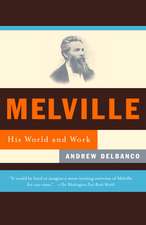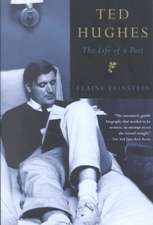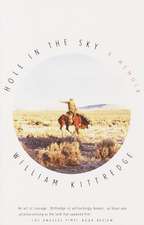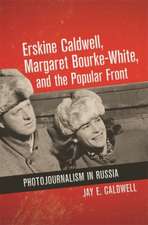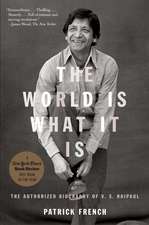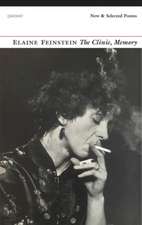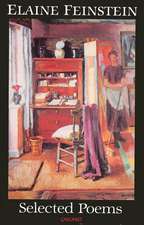Anna of All the Russias: A Life of Anna Akhmatova
Autor Elaine Feinsteinen Limba Engleză Paperback – 31 mar 2007
Preț: 114.10 lei
Nou
Puncte Express: 171
Preț estimativ în valută:
21.84€ • 22.93$ • 18.04£
21.84€ • 22.93$ • 18.04£
Carte tipărită la comandă
Livrare economică 30 ianuarie-13 februarie 25
Preluare comenzi: 021 569.72.76
Specificații
ISBN-13: 9781400033782
ISBN-10: 1400033780
Pagini: 331
Ilustrații: 16 PP. B&W
Dimensiuni: 134 x 201 x 19 mm
Greutate: 0.34 kg
Ediția:American.
Editura: Vintage Books USA
ISBN-10: 1400033780
Pagini: 331
Ilustrații: 16 PP. B&W
Dimensiuni: 134 x 201 x 19 mm
Greutate: 0.34 kg
Ediția:American.
Editura: Vintage Books USA
Notă biografică
Elaine Feinstein is a prizewinning poet and novelist and the author of highly praised biographies of Pushkin, Marina Tsvetayeva, and Ted Hughes. She lives in London.
Extras
St. Petersburg • 1913
The whole mournful city was drifting
Towards a destination nobody guessed.
—AKHMATOVA
Let me begin in 1913. The dark and glittering verses which open Akhmatova’s Poem Without a Hero circle about her memories of that year, the final moments of a corrupt and glamorous world. In the poem, Akhmatova is waiting for guests to celebrate New Year 1941. Candles have been lit, wine and crystal set out when, instead of her expected visitors, a sinister phantasmagoria of dead friends crowd in upon her, dressed as mummers. Their presence calls up St. Petersburg as it once was, when Akhmatova was twenty-four, a fashionable young woman already famous as a poet, with the violent upheavals of the twentieth century not yet under way.
In 1913 St. Petersburg was an Imperial capital, with a black and yellow flag flying over the Winter Palace, private carriages pulled by thoroughbred horses with footmen in uniform who rode on the running-boards. There were trams and trolleys and occasional motor cars. Enticing shop windows on the Nevsky Prospekt had oysters from Paris, lobsters from Ostend and “fruitcakes, smelling salts, Pears soap, playing cards, picture puzzles, striped blazers . . . and football jerseys in the colours of Oxford and Cambridge.” On the sunny side of Nevsky Prospekt bookstores sold the latest poetry.
Built below sea level, at the edge of the Baltic, St. Petersburg was always an unnatural city. Thousands of slave labourers died of disease and hunger to realise Peter the Great’s grand design of a window on the West. Even after he had declared St. Petersburg his new capital, wolves boldly entered the city at night as late as 1712, and occasionally devoured their prey in broad daylight. Floods constantly overwhelmed the islands, and in 1721 Peter himself was nearly drowned on Nevsky Prospekt. It is the city of Pushkin’s “Bronze Horseman,” where a poor clerk’s lover is carried away by the waters and Falconet’s grand statue of Peter pursues him when he dares to protest. It was Gogol’s city of shadows and phantoms. The poverty and squalor of the streets and squares still remained much as in Dostoevsky’s nightmare vision.
Akhmatova called St. Petersburg her cradle, even though she was not born there. In her autobiographical jottings, she describes childhood streets filled with organ-grinders, Tatar ragmen and tinsmiths, the houses painted different shades of red, front entrances scented with the perfume of ladies and the cigarettes of passing gentlemen, back staircases smelling of coffee, bliny, mushrooms and, frequently, cats.
1913 was the Jubilee of three hundred years of the Romanov dynasty, and in February all the main streets of the city were decorated, statues garlanded and portraits of a long line of tsars pasted to the front of buildings. Everything was done to impress foreign and provincial visitors. Electricity illuminated the Winter Palace, the golden spire of the Admiralty arch, other columns, arches and double-headed eagles. The rich dressed with flamboyance. At one opera house, in 1913, for a performance of Glinka’s patriotic A Life for the Tsar, the boxes blazed with jewels and tiaras. For the nobility, most of whom lived on or near the Nevsky Prospekt, there were balls and banquets. Everywhere military music celebrated the absolute rule of Nicholas II, and the magnificence of his empire.
On the February day which inaugurated the Jubilee celebrations, the Imperial family drove in an open carriage towards Kazan Cathedral. To protect the Tsar on his first public appearance since the revolution in 1905, one battalion of horse guards rode in front of his carriage and another behind. Imperial Guards lined the route. Tourists from all over the empire, and foreign dignitaries from the rest of Europe, were staggered by the splendour of the occasion.
Behind these central areas, St. Petersburg remained a city of filth and disease. Many factories were allowed to discharge their waste into the rivers and canals. With a cholera outbreak on average once every three years, the death rate was the highest of any capital city in Europe. Water had to be fetched in buckets and boiled before it was safe, but thirsty workers gave little attention to this and the general domestic water supply was a breeding-ground for typhus as well as cholera. London had eradicated similar problems in the nineteenth century by building a new system of sewers. No attempt was made to improve the situation in St. Petersburg until 1917.
Nicholas thought of himself as divinely appointed and the many peasants who still wrote directly to him for help saw him as a father who felt compassion for their difficulties. Over Nicholas’ vast empire, however, the memory of 1905 remained raw. Reprisals had included executions of suspected radicals and mass violence against ethnic minorities, particularly Jews, incited by the Tsar’s Prime
Minister, Stolypin. The ruling authorities remained suspicious of Poles and Jews, who were always regarded as likely revolutionaries, and indeed 1913 was the year of the Beilis trial, with its medieval trumped-up charge of child murder against a totally innocent Jew. Nevertheless, in 1913 Nicholas was confirmed in his delusion that his people loved him.
Of the skills required to run a country in pre-revolutionary ferment, it has to be said Nicholas had none. He was a shy man and had always been treated like a child by his family. He danced gracefully, rode well and spoke good English but his agonised cry when his father died at forty-nine was entirely appropriate: “What is going to happen to me and all of Russia? I was not prepared to be a Tsar. I never wanted to become one.” Nor was his Empress a popular
figure. She did not enjoy public occasions, and found the Jubilee celebrations a strain, even withdrawing from a gala performance at
the Maryinsky Theatre. She had acceded to the Russian throne at twenty-two and, although regarded as German by the Russians, she was in fact English. She ordered factory-produced furniture from the London department store Maples for the Winter Palace, where it looked out of place alongside the classic Empire style. She and Nicholas used domestic English endearments for one another such as “lovey” and “wifey.”
The Empress wanted desperately to give Russia a son, but she had four daughters before producing the Tsarevich Alex, who was soon discovered to suffer from haemophilia. This is what brought the strange figure of Rasputin into her life, since he did seem to possess some unexplained powers to stop the child bleeding—even, in one well-attested case, through the power of a telegram, the so-called “Spala miracle.” As an influential presence at court, Rasputin enjoyed gifts, bribes and sexual favours. Though it was said he had shrivelled private parts, he spent days in bathhouses and brothels with prostitutes. Rumours about his behaviour widely increased the unpopularity of the royal family. Nicholas, however, would not remove him from court while the Empress continued to put her faith in him as the only healer for her son.
No visitor would have recognised that “the moon was growing cold over the silver age.” It was a year of extraordinary cultural ferment. Nineteen-thirteen saw the serialisation of the first parts of Andrey Bely’s St. Petersburg, Russia’s most significant modernist novel, and the publication of Maxim Gorky’s celebrated autobiographical trilogy. There were three opera companies, and at the Maryinsky it was virtually impossible to get tickets when Fyodor Chaliapin was singing. On Wednesdays and Sundays there were performances of ballet, where Anna Pavlova and Vaclav Nijinsky could be seen, sometimes in the modernist choreography of Fokine. St. Petersburg enjoyed a great range of theatre, from the Imperially subsidised and traditional Alexandrinsky to the modernist experiments of Vsevolod Meyerhold. Numerous foreign films could be seen in cinemas all over St. Petersburg, while the most popular Russian film actress of the time was Vera Kholodnaya, adored in films that usually took the theme of love unrequited or humiliated.
All the avant-garde movements which were to make themselves felt in the arts took their shape between 1908 and 1913. Futurism drew on street theatre, performance poetry and bizarre costume, and was powerful in the visual arts. Whether poets used classical forms or not, they were instinctively opposed to the values of the society around them. Few of them were committed to political ways of changing that society, but Russian poets before 1913 felt that poetry might make anything happen.
Below street level on Mikhailovskaya Square, at the corner of Italyanskaya Street, lay the legendary cellar of “The Stray Dog,” owned by the actor Boris Pronin. To reach the Stray Dog you had to descend a narrow stone staircase and enter a doorway so low that a man had to take off his top hat. All the windows of the café were blocked up, as if to keep out the everyday world, and the walls and ceilings of low, curving plaster were painted with flowers and birds in brilliant colours by the artist Sergey Sudeikin. A group of bohemian artists gathered there after the theatres closed and often stayed talking until dawn. The clientele took pleasure in chilled Chablis, and anglophiles among them preferred the taste of white bulka to black Russian khleb.* It was a crowded room—very stuffy and not always merry, a society turned in on itself, almost as if unaware of what was happening in the streets above.
In 1913, the Stray Dog was one of the few places in the nightlife of St. Petersburg where literary and artistic people, often with little money, could find themselves welcome. Unlike La Coupole or Les Deux Magots, the Stray Dog did not function as an ordinary café: it was more like a club, with serious lectures, art exhibits and musical evenings. Guests had to sign in a thick volume bound in pigskin. Among the regulars were composers, painters, scholars and occasional foreign visitors such as Richard Strauss and the Italian Futurist Filippo Marinetti. Writers and artists were admitted free of charge, while ordinary punters, dismissively nicknamed “pharmacists,” had to pay a hefty 25 roubles a head.
They were glad to pay. Where else could they see the prima ballerina Tamara Karsavina on a giant mirror performing numbers choreographed by Fokine, or watch Vladimir Mayakovsky in the pose of a wounded gladiator lying in his famous striped shirt on a huge Turkish drum and triumphantly striking it at the appearance of each bizarrely arrayed comrade in futurism!
By 4 a.m. at the Stray Dog there would be tobacco fumes, empty bottles and only a few tables at the side still occupied. In an early poem, Akhmatova described the heady yet oppressive atmosphere:
We are all boozers here, and sleep around.
Together we make up a desolate crowd.
Even the painted birds and flowers on the walls
Seem to be longing for the clouds.
It was a world of every kind of experiment, especially sexual. Love between women or between men and ménages à trois were easily accepted among the intelligentsia. Anna Akhmatova, too, was part of this sexually promiscuous society, though she had married Nikolay Gumilyov on 25 April 1910. In old age, she spoke of their life together as “a marriage of strangers,” while Gumilyov described his own unhappiness at being married to “a witch, not a wife.”
Musicians like Artur Lurye, then thought of as a rising young composer, played the piano and Ilya Sats, who was famous for his plays at the Stanislavsky Arts Theatre in Moscow, sometimes experimented with a “prepared” piano in the manner of the much later American composer John Cage. Sats had thick black hair and a walrus moustache and wrote his most important work—The Goat-Legged Nymph—while sitting in the Stray Dog. Symbolists, Futurists, Acmeists, for all the differences that separated their aesthetic theories, were crammed together there at crowded little tables. Above all there were the poets. Vladimir Mayakovsky in his yellow tunic, Mikhail Kuzmin and Osip Mandelstam—a thin boy with long, dark eyelashes, sometimes remembered with a lily of the valley in his buttonhole. Akhmatova often sat smoking a cigarette at a side table, dressed in a tight skirt, with a scarf round her shoulders and a
necklace of black agate. She was always surrounded by a group of admirers. Alexander Blok, the great poet of the preceding generation, found Akhmatova’s beauty strangely terrifying. Mandelstam described her as “a black angel” with the mark of God upon her.
Akhmatova’s whole bearing changed when she stood to read her poems. She became pale and intense, almost as if hypnotising her listeners. One reason for her charm lay in her voice. The artist Yury Annenkov wrote: “I do not recall anyone else among the other poets who could read their poems so musically.” Georgy Adamovich remembers: “When people recall her today, they sometimes say she was beautiful. She was not, but she was more than beautiful, she was better than beautiful. I have never seen a woman . . . whose expressiveness, genuine unworldliness and inexplicable sudden appeal set her apart anywhere and among beautiful women everywhere.” Many artists tried to catch her poise in their portraits, notably Natan Altman. Akhmatova was always ambivalent about his celebrated portrait, which shows her in a silken blue dress, its folds almost Cubist in their emphasis, and a bright yellow shawl. Instead, she preferred a portrait by Alexander Tyshler.
The central figure of the cabaret at the Stray Dog was the actress Olga Glebova-Sudeikina. Olga had danced in the Maly Theatre and played Columbine in Meyerhold’s Columbine’s Scarf. Her performance in Sats’ The Goat-Legged Nymph was highly erotic. She also played the role of the Virgin in The Flight of the Virgin and Child to Egypt, with a script by Mikhail Kuzmin and music by Sats.
Olga’s apparition hovers over Akhmatova in Poem Without a Hero, a fluttering black and white fan in her hand, whispering of springtime, and evoking a dream of their lost youth together. Akhmatova called Olga her “double” but the two women did not much resemble each other physically. Olga had long golden braids, “like Melisande,” as Artur Lurye put it. Whatever Olga’s charms, Akhmatova’s beauty was of another kind. She was elegantly slender to the point of angularity, with a straight back and haughty bearing. Her face had high cheekbones, huge grey eyes and a soft mouth. Her black hair was caught back severely at her neck and cut into a fringe over her forehead. Her features had a classical perfection, though seen from the side her aquiline nose would not be admired today. “Her face and her entire physical appearance was striking. When she stood on the stage, with her shawl falling off her shoulders, she had a strange poised nobility which blended harmoniously with her image.”
Even her jewellery took on an iconic quality. Akhmatova’s grandmother had bequeathed her a black ring, a band of even width covered with gold enamel. In the centre was a small diamond. Anna was superstitious about its powers to protect the wearer.
In Akhmatova’s “A Petersburg Tale,” the figure of “Confusion Psyche” lives in an apartment furnished in the style of Olga’s home:
Your house was flashier than a circus wagon.
Dilapidated Cupids stood on guard
There at the side of Venus’ altar.
Your song birds were uncaged,
Your bedroom decorated like an arbour.
Olga was passionately interested in Italian commedia dell’arte, masks and puppets. Rather surprisingly, she came from the province of Pskov where her great-grandfather had been a serf, while her father was one of the poor functionaries described by Dostoevsky. Not everyone found her interesting. Nadezhda Mandelstam, Osip’s wife, wrote of her with some unkindness as one of the “dolls” of St. Petersburg, and comments on her faded, tired look, even while admitting she was a “nice, light-headed, flighty creature.” Vera de Bosset—in later life the wife of Igor Stravinsky—married Sudeikin after taking him away from Olga; she claimed “basically she was a rather empty-headed little thing whose only interest was suitors.” Artur Lurye, however, who lived with her for a time, observed that she was exceptionally musical and had an enchanting laugh and a playful manner. She enjoyed making dolls, and kept her treasures—Don Juan, the Queen of the Night and Desdemona—in special boxes, only taking them out when guests came to visit her. She liked to walk to the Alexandrovsky market, where she bought old china and knick-knacks such as snuff boxes and miniatures. She loved to entertain in the famous Ozarovsky “theatre house.” This exquisite little house contained Elizabethan furniture made of Kerelian birch, harpsichords, Venetian mirrors, Russian glass . . . She had a wonderful ear, and an extraordinary memory for music. She could sing anything at a moment’s notice.”
From the Hardcover edition.
The whole mournful city was drifting
Towards a destination nobody guessed.
—AKHMATOVA
Let me begin in 1913. The dark and glittering verses which open Akhmatova’s Poem Without a Hero circle about her memories of that year, the final moments of a corrupt and glamorous world. In the poem, Akhmatova is waiting for guests to celebrate New Year 1941. Candles have been lit, wine and crystal set out when, instead of her expected visitors, a sinister phantasmagoria of dead friends crowd in upon her, dressed as mummers. Their presence calls up St. Petersburg as it once was, when Akhmatova was twenty-four, a fashionable young woman already famous as a poet, with the violent upheavals of the twentieth century not yet under way.
In 1913 St. Petersburg was an Imperial capital, with a black and yellow flag flying over the Winter Palace, private carriages pulled by thoroughbred horses with footmen in uniform who rode on the running-boards. There were trams and trolleys and occasional motor cars. Enticing shop windows on the Nevsky Prospekt had oysters from Paris, lobsters from Ostend and “fruitcakes, smelling salts, Pears soap, playing cards, picture puzzles, striped blazers . . . and football jerseys in the colours of Oxford and Cambridge.” On the sunny side of Nevsky Prospekt bookstores sold the latest poetry.
Built below sea level, at the edge of the Baltic, St. Petersburg was always an unnatural city. Thousands of slave labourers died of disease and hunger to realise Peter the Great’s grand design of a window on the West. Even after he had declared St. Petersburg his new capital, wolves boldly entered the city at night as late as 1712, and occasionally devoured their prey in broad daylight. Floods constantly overwhelmed the islands, and in 1721 Peter himself was nearly drowned on Nevsky Prospekt. It is the city of Pushkin’s “Bronze Horseman,” where a poor clerk’s lover is carried away by the waters and Falconet’s grand statue of Peter pursues him when he dares to protest. It was Gogol’s city of shadows and phantoms. The poverty and squalor of the streets and squares still remained much as in Dostoevsky’s nightmare vision.
Akhmatova called St. Petersburg her cradle, even though she was not born there. In her autobiographical jottings, she describes childhood streets filled with organ-grinders, Tatar ragmen and tinsmiths, the houses painted different shades of red, front entrances scented with the perfume of ladies and the cigarettes of passing gentlemen, back staircases smelling of coffee, bliny, mushrooms and, frequently, cats.
1913 was the Jubilee of three hundred years of the Romanov dynasty, and in February all the main streets of the city were decorated, statues garlanded and portraits of a long line of tsars pasted to the front of buildings. Everything was done to impress foreign and provincial visitors. Electricity illuminated the Winter Palace, the golden spire of the Admiralty arch, other columns, arches and double-headed eagles. The rich dressed with flamboyance. At one opera house, in 1913, for a performance of Glinka’s patriotic A Life for the Tsar, the boxes blazed with jewels and tiaras. For the nobility, most of whom lived on or near the Nevsky Prospekt, there were balls and banquets. Everywhere military music celebrated the absolute rule of Nicholas II, and the magnificence of his empire.
On the February day which inaugurated the Jubilee celebrations, the Imperial family drove in an open carriage towards Kazan Cathedral. To protect the Tsar on his first public appearance since the revolution in 1905, one battalion of horse guards rode in front of his carriage and another behind. Imperial Guards lined the route. Tourists from all over the empire, and foreign dignitaries from the rest of Europe, were staggered by the splendour of the occasion.
Behind these central areas, St. Petersburg remained a city of filth and disease. Many factories were allowed to discharge their waste into the rivers and canals. With a cholera outbreak on average once every three years, the death rate was the highest of any capital city in Europe. Water had to be fetched in buckets and boiled before it was safe, but thirsty workers gave little attention to this and the general domestic water supply was a breeding-ground for typhus as well as cholera. London had eradicated similar problems in the nineteenth century by building a new system of sewers. No attempt was made to improve the situation in St. Petersburg until 1917.
Nicholas thought of himself as divinely appointed and the many peasants who still wrote directly to him for help saw him as a father who felt compassion for their difficulties. Over Nicholas’ vast empire, however, the memory of 1905 remained raw. Reprisals had included executions of suspected radicals and mass violence against ethnic minorities, particularly Jews, incited by the Tsar’s Prime
Minister, Stolypin. The ruling authorities remained suspicious of Poles and Jews, who were always regarded as likely revolutionaries, and indeed 1913 was the year of the Beilis trial, with its medieval trumped-up charge of child murder against a totally innocent Jew. Nevertheless, in 1913 Nicholas was confirmed in his delusion that his people loved him.
Of the skills required to run a country in pre-revolutionary ferment, it has to be said Nicholas had none. He was a shy man and had always been treated like a child by his family. He danced gracefully, rode well and spoke good English but his agonised cry when his father died at forty-nine was entirely appropriate: “What is going to happen to me and all of Russia? I was not prepared to be a Tsar. I never wanted to become one.” Nor was his Empress a popular
figure. She did not enjoy public occasions, and found the Jubilee celebrations a strain, even withdrawing from a gala performance at
the Maryinsky Theatre. She had acceded to the Russian throne at twenty-two and, although regarded as German by the Russians, she was in fact English. She ordered factory-produced furniture from the London department store Maples for the Winter Palace, where it looked out of place alongside the classic Empire style. She and Nicholas used domestic English endearments for one another such as “lovey” and “wifey.”
The Empress wanted desperately to give Russia a son, but she had four daughters before producing the Tsarevich Alex, who was soon discovered to suffer from haemophilia. This is what brought the strange figure of Rasputin into her life, since he did seem to possess some unexplained powers to stop the child bleeding—even, in one well-attested case, through the power of a telegram, the so-called “Spala miracle.” As an influential presence at court, Rasputin enjoyed gifts, bribes and sexual favours. Though it was said he had shrivelled private parts, he spent days in bathhouses and brothels with prostitutes. Rumours about his behaviour widely increased the unpopularity of the royal family. Nicholas, however, would not remove him from court while the Empress continued to put her faith in him as the only healer for her son.
No visitor would have recognised that “the moon was growing cold over the silver age.” It was a year of extraordinary cultural ferment. Nineteen-thirteen saw the serialisation of the first parts of Andrey Bely’s St. Petersburg, Russia’s most significant modernist novel, and the publication of Maxim Gorky’s celebrated autobiographical trilogy. There were three opera companies, and at the Maryinsky it was virtually impossible to get tickets when Fyodor Chaliapin was singing. On Wednesdays and Sundays there were performances of ballet, where Anna Pavlova and Vaclav Nijinsky could be seen, sometimes in the modernist choreography of Fokine. St. Petersburg enjoyed a great range of theatre, from the Imperially subsidised and traditional Alexandrinsky to the modernist experiments of Vsevolod Meyerhold. Numerous foreign films could be seen in cinemas all over St. Petersburg, while the most popular Russian film actress of the time was Vera Kholodnaya, adored in films that usually took the theme of love unrequited or humiliated.
All the avant-garde movements which were to make themselves felt in the arts took their shape between 1908 and 1913. Futurism drew on street theatre, performance poetry and bizarre costume, and was powerful in the visual arts. Whether poets used classical forms or not, they were instinctively opposed to the values of the society around them. Few of them were committed to political ways of changing that society, but Russian poets before 1913 felt that poetry might make anything happen.
Below street level on Mikhailovskaya Square, at the corner of Italyanskaya Street, lay the legendary cellar of “The Stray Dog,” owned by the actor Boris Pronin. To reach the Stray Dog you had to descend a narrow stone staircase and enter a doorway so low that a man had to take off his top hat. All the windows of the café were blocked up, as if to keep out the everyday world, and the walls and ceilings of low, curving plaster were painted with flowers and birds in brilliant colours by the artist Sergey Sudeikin. A group of bohemian artists gathered there after the theatres closed and often stayed talking until dawn. The clientele took pleasure in chilled Chablis, and anglophiles among them preferred the taste of white bulka to black Russian khleb.* It was a crowded room—very stuffy and not always merry, a society turned in on itself, almost as if unaware of what was happening in the streets above.
In 1913, the Stray Dog was one of the few places in the nightlife of St. Petersburg where literary and artistic people, often with little money, could find themselves welcome. Unlike La Coupole or Les Deux Magots, the Stray Dog did not function as an ordinary café: it was more like a club, with serious lectures, art exhibits and musical evenings. Guests had to sign in a thick volume bound in pigskin. Among the regulars were composers, painters, scholars and occasional foreign visitors such as Richard Strauss and the Italian Futurist Filippo Marinetti. Writers and artists were admitted free of charge, while ordinary punters, dismissively nicknamed “pharmacists,” had to pay a hefty 25 roubles a head.
They were glad to pay. Where else could they see the prima ballerina Tamara Karsavina on a giant mirror performing numbers choreographed by Fokine, or watch Vladimir Mayakovsky in the pose of a wounded gladiator lying in his famous striped shirt on a huge Turkish drum and triumphantly striking it at the appearance of each bizarrely arrayed comrade in futurism!
By 4 a.m. at the Stray Dog there would be tobacco fumes, empty bottles and only a few tables at the side still occupied. In an early poem, Akhmatova described the heady yet oppressive atmosphere:
We are all boozers here, and sleep around.
Together we make up a desolate crowd.
Even the painted birds and flowers on the walls
Seem to be longing for the clouds.
It was a world of every kind of experiment, especially sexual. Love between women or between men and ménages à trois were easily accepted among the intelligentsia. Anna Akhmatova, too, was part of this sexually promiscuous society, though she had married Nikolay Gumilyov on 25 April 1910. In old age, she spoke of their life together as “a marriage of strangers,” while Gumilyov described his own unhappiness at being married to “a witch, not a wife.”
Musicians like Artur Lurye, then thought of as a rising young composer, played the piano and Ilya Sats, who was famous for his plays at the Stanislavsky Arts Theatre in Moscow, sometimes experimented with a “prepared” piano in the manner of the much later American composer John Cage. Sats had thick black hair and a walrus moustache and wrote his most important work—The Goat-Legged Nymph—while sitting in the Stray Dog. Symbolists, Futurists, Acmeists, for all the differences that separated their aesthetic theories, were crammed together there at crowded little tables. Above all there were the poets. Vladimir Mayakovsky in his yellow tunic, Mikhail Kuzmin and Osip Mandelstam—a thin boy with long, dark eyelashes, sometimes remembered with a lily of the valley in his buttonhole. Akhmatova often sat smoking a cigarette at a side table, dressed in a tight skirt, with a scarf round her shoulders and a
necklace of black agate. She was always surrounded by a group of admirers. Alexander Blok, the great poet of the preceding generation, found Akhmatova’s beauty strangely terrifying. Mandelstam described her as “a black angel” with the mark of God upon her.
Akhmatova’s whole bearing changed when she stood to read her poems. She became pale and intense, almost as if hypnotising her listeners. One reason for her charm lay in her voice. The artist Yury Annenkov wrote: “I do not recall anyone else among the other poets who could read their poems so musically.” Georgy Adamovich remembers: “When people recall her today, they sometimes say she was beautiful. She was not, but she was more than beautiful, she was better than beautiful. I have never seen a woman . . . whose expressiveness, genuine unworldliness and inexplicable sudden appeal set her apart anywhere and among beautiful women everywhere.” Many artists tried to catch her poise in their portraits, notably Natan Altman. Akhmatova was always ambivalent about his celebrated portrait, which shows her in a silken blue dress, its folds almost Cubist in their emphasis, and a bright yellow shawl. Instead, she preferred a portrait by Alexander Tyshler.
The central figure of the cabaret at the Stray Dog was the actress Olga Glebova-Sudeikina. Olga had danced in the Maly Theatre and played Columbine in Meyerhold’s Columbine’s Scarf. Her performance in Sats’ The Goat-Legged Nymph was highly erotic. She also played the role of the Virgin in The Flight of the Virgin and Child to Egypt, with a script by Mikhail Kuzmin and music by Sats.
Olga’s apparition hovers over Akhmatova in Poem Without a Hero, a fluttering black and white fan in her hand, whispering of springtime, and evoking a dream of their lost youth together. Akhmatova called Olga her “double” but the two women did not much resemble each other physically. Olga had long golden braids, “like Melisande,” as Artur Lurye put it. Whatever Olga’s charms, Akhmatova’s beauty was of another kind. She was elegantly slender to the point of angularity, with a straight back and haughty bearing. Her face had high cheekbones, huge grey eyes and a soft mouth. Her black hair was caught back severely at her neck and cut into a fringe over her forehead. Her features had a classical perfection, though seen from the side her aquiline nose would not be admired today. “Her face and her entire physical appearance was striking. When she stood on the stage, with her shawl falling off her shoulders, she had a strange poised nobility which blended harmoniously with her image.”
Even her jewellery took on an iconic quality. Akhmatova’s grandmother had bequeathed her a black ring, a band of even width covered with gold enamel. In the centre was a small diamond. Anna was superstitious about its powers to protect the wearer.
In Akhmatova’s “A Petersburg Tale,” the figure of “Confusion Psyche” lives in an apartment furnished in the style of Olga’s home:
Your house was flashier than a circus wagon.
Dilapidated Cupids stood on guard
There at the side of Venus’ altar.
Your song birds were uncaged,
Your bedroom decorated like an arbour.
Olga was passionately interested in Italian commedia dell’arte, masks and puppets. Rather surprisingly, she came from the province of Pskov where her great-grandfather had been a serf, while her father was one of the poor functionaries described by Dostoevsky. Not everyone found her interesting. Nadezhda Mandelstam, Osip’s wife, wrote of her with some unkindness as one of the “dolls” of St. Petersburg, and comments on her faded, tired look, even while admitting she was a “nice, light-headed, flighty creature.” Vera de Bosset—in later life the wife of Igor Stravinsky—married Sudeikin after taking him away from Olga; she claimed “basically she was a rather empty-headed little thing whose only interest was suitors.” Artur Lurye, however, who lived with her for a time, observed that she was exceptionally musical and had an enchanting laugh and a playful manner. She enjoyed making dolls, and kept her treasures—Don Juan, the Queen of the Night and Desdemona—in special boxes, only taking them out when guests came to visit her. She liked to walk to the Alexandrovsky market, where she bought old china and knick-knacks such as snuff boxes and miniatures. She loved to entertain in the famous Ozarovsky “theatre house.” This exquisite little house contained Elizabethan furniture made of Kerelian birch, harpsichords, Venetian mirrors, Russian glass . . . She had a wonderful ear, and an extraordinary memory for music. She could sing anything at a moment’s notice.”
From the Hardcover edition.
Recenzii
“Enthralling, anecdote-rich . . . Feinstein has written a highly engaging biography of this great poet and determined woman, a fine companion volume to her previous life of Marina Tsvetaeva. It makes a superb introduction to Akhmatova and her world.”–Michael Dirda, The Washington Post Book World“Rich, affectionate, unsparing”–John Leonard, Harper’s Magazine “Illuminating . . . Tantalizing glimpses of an extraordinary woman living in extraordinary times.” –Olga Grushin, The New York Times“Feinstein never loses sight of her subject’s greatness . . . Akhmatova deserves the title Anna of All the Russias because she never forsook her country . . . Although ordinary Russians recognized an aristocrat in her rather aloof, imposing figure, her life and her poetry put her at one with her nation.”–Carl Rollyson, The New York Sun“In the first biography in decades, Feinstein skillfully chronicles Akhmatova’s shockingly destitute life and untangles her snarled and painful relationships . . . Akhmatova’s soulful work spoke for the entire tyrannized country, and what distinguishes this judicious and riveting biography most are Feinstein’s translations of Akhmatova’s incandescent poems of ‘steely defiance.’”– Booklist, starred review“With her vivid, immensely readable biography, Elaine Feinstein gives us Akhmatova in all her profound, complicated and deeply moving glory.”–Douglas Smith, The Seattle Times“As this eminently readable account makes apparent, no one was more aware of her symbolic value than Akhmatova herself. . . Feinstein deserves credit for refusing to idealize a woman whose words were powerful enough to potentially get her killed." –Megan O’Grady, Vogue“A worthy and enjoyable biography. . . Feinstein weaves her poems through the text while providing great detail on the significant relationships of her life.” –Library Journal“Eminently readable… Akhmatova is a figure that Russians return to again and again, the better to understand their own history. Feinstein has done English-speaking readers a great favour by making Akhmatova’s life story, and therefore her poetry, more accessible to us than ever before.” –Anne Applebaum, The Spectator“A brilliant new biography… [and a] compulsively readable account… Elaine Feinstein has managed to write a biography that is both scholarly and emotive... As a poet herself, Feinstein is adept at showing just why and how Akhmatova’s unique voice has intoxicated readers ever since.” –Olivia Cole, The Independent“Elaine Feinstein’s achievement is to show us the life of an extraordinary woman in gleaming fragments, and to demonstrate, through so many witnesses, how she was worshipped.” –Neal Ascherson, The Observer“Feinstein is splendidly qualified to add to the story . . . A fresh, informative glimpse of how Akhmatova is seen now, how she has fared in the thicket of memoirs and revisions which have emerged in the last few decades. And how a new post-Soviet Russia has come to terms with her stature . . . There is fresh information here. There is a strong vivid context provided for the poems. The poems themselves are offered with a clear and clean eloquence. Akhmatova’s luck has held.” –Eavan Boland, The Independent on Sunday“Her biographer needs… adroitness to make space in one book for all the components of her complicated life and to find the right focus for such a diffuse and frequently interrupted career… at its centre is the compelling figure of Akhmatova herself… Not an easy person then, but a grand one, and a great poet.” –Lucy Hughes-Hallett, The Sunday Times
Descriere
Focusing on the legendary Russian poet, this comprehensive biography is a rich narrative of the dramatic life of Anna Akhmatova. of illustrations.
